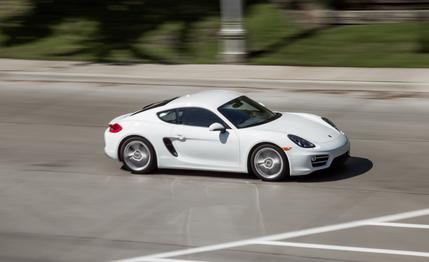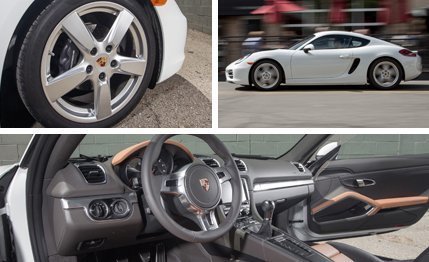 Instrumented Test
Instrumented Test
Sink the clutch and squeeze the brake pedal. Float the weighty stick through the gears from third to second without so much as brushing the gate. Foot cocked like a pigeon-toed toddler, your heel drops, your ankle rolls, and the outside of your right sole jabs the throttle, all while maintaining even pressure on the brakes. Revs rise, your left foot lifts, and the payoff—the payoff is that flat-six barking at 5000 rpm and the perfect setup for this tight right-hander coming up.

In a Cayman, you’re a star. Were this a Wachowski film, the corner would play out for six whole minutes in slow motion. Never mind that your flawless, rev-matched downshift probably took longer than the slowest gear change ever by a Porsche Doppelkupplung (PDK) automatic. Man and machine are equal partners here, like pedaling a fixed-gear bike but with a lower calorie burn.
This is a Porsche Cayman. Period. It’s not the big-engined S model, nor does it pack the infallible PDK. In this particular stripped-naked example, there is no launch control, no loud button for the exhaust, and no pimply chronometer protruding from the dash. It’s the purest example of the purist’s car. Of course, even this scarcely optioned example still claims $16,750 in extras, including brake-based torque vectoring and adaptive suspension. Everything’s relative, right?

Shifting yourself isn’t for those with quarter-mile egos. At the track, this Cayman needs an extra 1.6 seconds to hit 60 mph compared with the more powerful, PDK-equipped Cayman S we tested recently. It also requires 14.2 seconds (versus the S’s 12.6 seconds) to clear the quarter-mile. But straight-line speed is a footnote to the Cayman tone poem, and the base car is blessed with the same preternaturally gifted chassis found under the S.
Both Caymans posted virtually identical braking and skidpad figures. More important, the car dissects the road with surgical precision. The Cayman’s suspension flattens both body roll and the Midwest’s worst roads. And while the steering wheel no longer wriggles in your hands like it once did, a Cayman’s is still among the most tactile helms in a modern car.
It’s good enough to be too good. The Pirelli P Zero tires, tasked with wrangling just 275 humble horsepower and the most agile chassis we know, place the limits at improbable heights. You’ll assault roads with speed and fluidity, but for some, the Cayman will struggle to instill the deep satisfaction that comes from being challenged. It’s a car so exceptional that it renders many corners unexceptional.